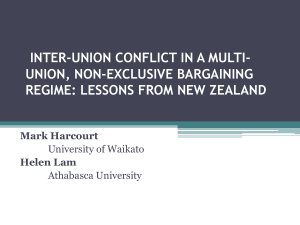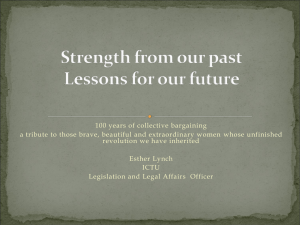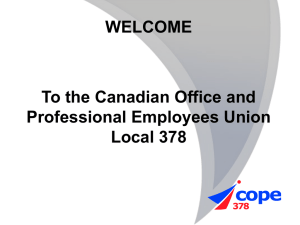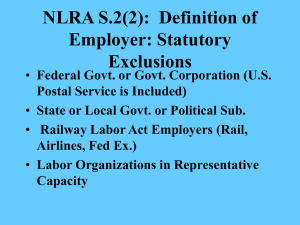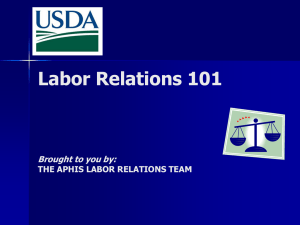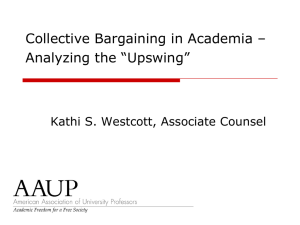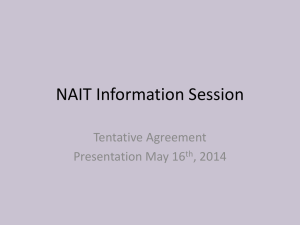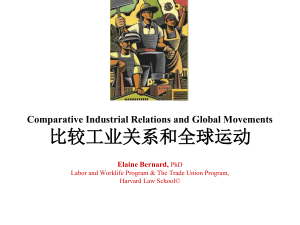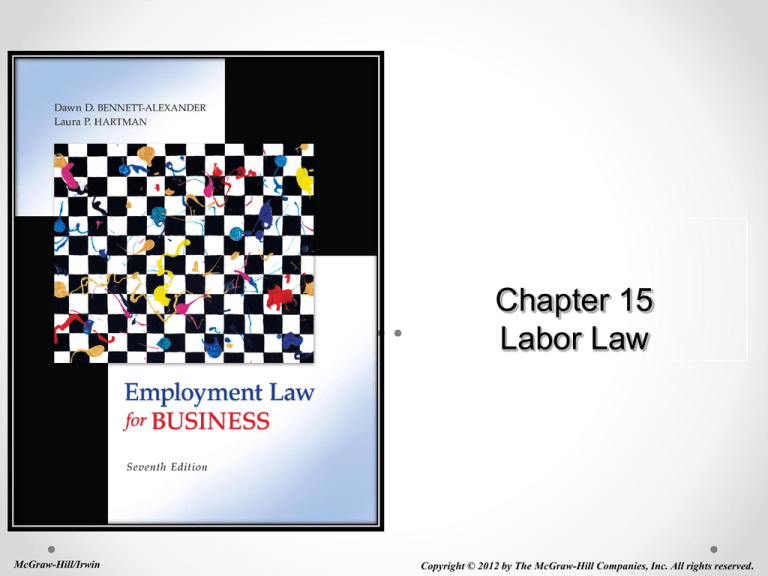
Chapter 15
Labor Law
McGraw-Hill/Irwin
Copyright © 2012 by The McGraw-Hill Companies, Inc. All rights reserved.
Learning Objectives
Discuss the history of unions in the United
States
Identify the Norris-LaGuardia Act of 1932 and
what it covers
Identify the National Labor Relations Act of 1935
(Wagner Act) and what it requires
15-2
Learning Objectives
List and explain several collective bargaining
agreement clauses
Explain unfair labor practices and give examples
Describe the Taft-Hartley Act of 1947 and its
requirements
15-3
Learning Objectives
Define the Landrum-Griffin Act of 1959 (Labor
Management Reporting and Disclosure Act) and
its provisions
Discuss collective bargaining in the public sector
and how it differs from the private sector
15-4
Coming Together on Issues
Labor law – different and discrete from
employment law
Collective bargaining: Negotiations and
agreements between management and labor
about wages, hours, and other terms and
conditions of employment
Nature of the American economy – shift from
agrarian to industrial
Basis for modern labor issues
15-5
A Historical Accounting
Criminal conspiracy laws – Early union activity
considered to be common law criminal
conspiracies
Injunctions: Court order requiring individuals or
groups of persons to refrain from performing
certain acts that the court has determined will do
irreparable harm
Yellow dog contracts: Agreements stating that
employees do not belong to a union and will not join
one; now illegal
15-6
A Historical Accounting
Antitrust attacks
Sherman Antitrust Act
Secondary boycotts: Union pressure on
management by getting others who do business with
management to cease
Clayton act
Issue of injunction against labor
Constitutional challenges to early congressional
enactments
15-7
Out of Necessity Comes Change
National War Labor Board
Peaceful resolution of labor disputes
National Industrial Recovery Act
Put business in charge of regulating prices and
production
Established a minimum wage
Gave workers collective bargaining and other rights
Declared unconstitutional in 1935
15-8
Out of Necessity Comes Change
Decrease in unionization
Reduction in heavily unionized industries
Aggressive nonunionizing campaigns by employers
Union concessions during downturns in the economy
North American Free Trade Agreement (NAFTA)
International competition
Labor unions still remain an important part of the
workplace
15-9
Labor Laws
Began with
Restricting court responses to union activity
Establishing the right of employees to form labor
organizations
Protection against unfair labor practices
Unions gained power and abused it, resulting in
additional labor management legislation
15-10
The Norris-Laguardia Act
The first major labor law statute enacted in the
United States
Provisions
Curbed courts’ power to intervene in labor disputes
Issue of injunctive relief
Yellow contracts made non-enforceable in any court
in the U.S.
Significant impact in curbing prosecution under the
antitrust laws
15-11
The National Labor Relations Act of
1935 (Wagner Act)
The National Labor Relations Act
Enacted to avoid the unconstitutional delegation of
legislative power
Outlines unfair labor practices
Administered by NLRB
Unfair job practices by unions are notably
missing from the act
15-12
The National Labor Relations Act of
1935 (Wagner Act)
The National Labor Relations Board
Enforces labor laws in the private sector and
conducts union elections
Community of interests – formation of a bargaining
unit
Concerted activity
Union organizing
Discussion of unionization and solicitation of union
support
15-13
The National Labor Relations Act of
1935 (Wagner Act)
Unions
Meaning
Community of
interests
Factors employees have in common for bargaining
purposes
Bargaining unit
The group of employees in a workplace that have
the legal right to bargain with the employer
Shop steward
Union member chosen as intermediary between
union members and employer
15-14
The National Labor Relations Act of
1935 (Wagner Act)
Unions
Meaning
Collective
bargaining
agreement
Negotiated contract between labor and
management
Industrial union
Union organized across an industry, regardless of
members’ job type
Craft unions
Unions organized by the employee’s craft or trade
Business agent
The representative of a union, usually craft
15-15
The National Labor Relations Act of
1935 (Wagner Act)
Good faith bargaining
Mandatory subjects of bargaining: Wages, hours,
and other conditions of employment, which, by law,
must be negotiated between labor and management
Permissive subjects of bargaining: Nonmandatory
subjects that can be negotiated between labor and
management
Closed shop: Employer hires only union members
Bad-faith bargaining
15-16
The National Labor Relations Act of
1935 (Wagner Act)
Duty of fair representation
Requires the union to represent all employees fairly
and nondiscriminatorily
15-17
Collective Bargaining Agreements
Management security clause: Parties agree
that management has the right to run the
business and make appropriate business
decisions as long as applicable laws and
agreements are complied with
Midterm negotiations: Collective bargaining
negotiations during the term of the contract
15-18
Unfair Labor Practices
Unfair labour practices may include
Refusal to bargain in good faith
Engaging in activities that would tend to attempt to
control or influence the union
Interfering with union’s affairs
Discriminating against employees who join or assist
unions
Strikes and Lockouts
15-19
The Taft-Hartley Act
Amendment to the NLRA
Enacted to curb excesses by unions
Section 7, unfair labor practice for unions to
Restrain employees in the exercise of their rights or
employers in the selection of their representatives for
collective bargaining
Cause an employer to discriminate against an
employee
15-20
The Taft-Hartley Act
Section 7, unfair labor practice for unions to
(continued)
Refuse to bargain with an employer
Engage in jurisdictional or secondary boycotts.
Charge excess or discriminatory initiation fees or
dues.
Cause an employee to pay for goods or services that
are not provided
15-21
The Taft-Hartley Act
Key Terms
Meaning
Right-to-work laws Permits employees to choose not to become a part of the
union
Union shop
Union and management agree that employees must be
a member of the union
Union shop clause
Provision in a collective bargaining agreement allowing
a union shop
Agency shop clause Requires nonunion members to pay union dues without
having to be subject to the union rules
Free riders
Bargaining unit employees who do not pay dues but
whom the union is still obligated to represent
14-22
15-22
The Landrum-Griffin Act
Also known as the Labor Management
Reporting and Disclosure Act
Enacted in response to congressional
investigations into union corruption
Bill of rights for union members
Procedures for holding union elections
Safeguarding funds
15-23
Union Members’ Bill of Rights
Right to attend union meetings, vote on union
business, and nominate candidates for union
Right to bring an agency or court action against
the union after exhausting union procedures
Certain procedures must be followed before any
dues or initiation fee increases
Full and fair hearing when being disciplined by
the union; exception – failure to pay dues
15-24
Labor Relations in the Public Sector
Federal employees
Many states have collective bargaining statutes
covering most public employees
Federal restrictions
Civil Service Reform Act of 1978
Federal Labor Relations Authority
15-25
Labor Relations in the Public Sector
State, county, and municipal public employees
Professional associations
Craft unions
Industrial-type unions
AFL-CIO
Difference between public and private collective
bargaining
15-26
Management Tips
If employees decide they wish to unionize, do
not try to negatively influence the decision
Do not assume any employee you speak to for
the purpose of persuading employees not to
unionize will keep the conversation confidential
Know the kinds of things the employer can
legally do to influence the unionizing decision,
and do only those things that are permissible
15-27
Management Tips
Once the union is in place, conduct all
negotiations only with the union representatives
Treat the collective bargaining process as one
would any business activity
Know what the law requires
15-28
Management Tips
Keep the lines of communication open
Try to keep the “us versus them” mentality from
having a negative impact on the collective
bargaining process
Play hardball without setting management up for
an unfair labor practice charge
15-29

